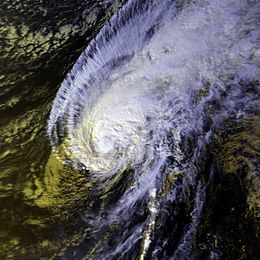Hurricane Iwa
| Category 1 hurricane (SSHWS/NWS) | |

Hurricane Iwa satellite image.
|
|
| Formed | November 19, 1982 |
|---|---|
| Dissipated | November 25, 1982 |
| Highest winds |
1-minute sustained: 90 mph (150 km/h) |
| Lowest pressure | 968 mbar (hPa); 28.59 inHg |
| Fatalities | 1 direct, 3 indirect |
| Damage | $312 million (1982 USD) |
| Areas affected | Hawaiʻi |
| Part of the 1982 Pacific hurricane season | |
Hurricane Iwa, taken from the Hawaiian language name for the frigatebird (ʻiwa, lit. "Thief"), was at the time the costliest hurricane to affect the state of Hawaiʻi. Iwa was the twenty-third tropical storm and the twelfth and final hurricane of the 1982 Pacific hurricane season. It developed from an active trough of low pressure near the equator on November 19. The storm moved erratically northward until becoming a hurricane on November 23 when it began accelerating to the northeast in response to strong upper-level flow from the north. Iwa passed within 25 miles of the island of Kauaʻi with peak winds of 90 mph (145 km/h) on November 23 (November 24 Coordinated Universal Time), and the next day it became extratropical to the northeast of the state.
The hurricane devastated the islands of Niʻihau, Kauaʻi, and Oʻahu with wind gusts exceeding 100 mph (160 km/h) and rough seas exceeding 30 feet (9 m) in height. The first significant hurricane to hit the Hawaiian Islands since statehood in 1959, Iwa severely damaged or destroyed 2,345 buildings, including 1,927 houses, leaving 500 people homeless. Damage throughout the state totaled $312 million (1982 USD, $774 million 2017 USD). One person was killed from the high seas, and three deaths were indirectly related to the hurricane's aftermath.
A very active trough of low pressure persisted along the equator in the middle of November, with westerly surface winds and windspread convection located along the trough from 140° W to 140° E. An organized circulation developed near Palmyra Atoll on November 18, and steadily developed as it drifted westward. Though very late in the season, warm temperatures to the south of the Hawaiian Islands due to the strongest El Nino in many years allowed the disturbance to develop into Tropical Storm Iwa on November 19 while located about 970 miles (1,760 km) southwest of the southernmost point in Hawaii. The storm tracked slowly northward after forming and initially remained a weak tropical storm. After turning to the northeast, Iwa began slowly intensifying, and on November 23 after turning to the north-northwest Iwa strengthened into a hurricane while located 580 miles (930 km) southwest of the southern tip of Hawaii.
...
Wikipedia
